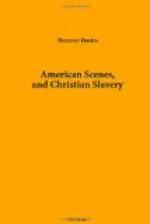Young men in great cities (it was observed) were in great danger, chiefly from example. They met with those who were older in sin than themselves—who prided themselves on knowing where the best oysters were sold, the cheapest horses to be hired, or the cheapest boats to be engaged for the Sunday’s excursion. Young men were ready to think, “If I don’t do this, I may do something worse.” The fallacy and danger of this mode of reasoning were exposed. It might be employed to excuse any sin. Public places of amusement were highways to destruction. Ah! how those old people in that little cottage—surrounded with a stone wall—on the hill side—far away—would weep, if they knew their son was treading on the verge of these burning craters! Familiarity with Sabbath-breaking destroyed the sense of guilt. The young medical student when he first visited the dissecting-room, and the soldier when he first stood on the field of battle, were sensible of misgivings, against which repetition only made them proof,—each gradually losing his first sensations.
The desecration of the Sabbath was a greater evil to society than any tyrant could inflict. How would any infringement of civil rights be resisted! Here was an infringement with consequences infinitely more injurious; and yet the press were dumb dogs, and the pulpit itself was not guiltless!
This masterly discourse was read, but read in such a manner as to lose none of its effect. It occupied upwards of an hour. My irresistible impression as I listened was, There is a man of God! Truly a light shining in a dark place; for, as I returned to my lodgings, I found the coffee-houses, oyster-saloons, and theatres all open, just as on any other day, only more thronged with customers. How much such discourses are needed in this place, I leave you to judge from the following extract from the New Orleans Guide:—
“The greatest market-day is Sunday. At break of day the gathering commences,—youth and age—beauty and not so beautiful—all colours, nations, and tongues are co-mingled in one heterogeneous mass of delightful confusion. The traveller who leaves the city without visiting one of the popular markets on Sunday morning has suffered a rare treat to escape him.”
On the evening of the next day, being the first Monday in the month, I went to the “Concert” for prayer, which had been announced the day before. It was held in a vestry or a school-room under the church. About sixty or seventy persons were in attendance. When I got there, they were singing the last verse of
“O’er the gloomy Mils of darkness,” &c.
A gentleman then gave an address. His object was to show that extensive fields were open in various parts of the world for the introduction of the Gospel. There was nothing clerical in his appearance, and he boggled a great deal; but, as he said “We, the ministers of the Gospel,” I inferred that he was the pastor of some other Presbyterian church in the city. Behind the desk, where sat Dr. S——, was hung up a missionary map of the world, drawn on canvas, and illuminated from behind. It was an excellent device. All missionary prayer-meetings should be furnished with one. Those parts where the Gospel is already preached were light, the realms of Heathenism dark, the lands of Popery red, and so forth.




